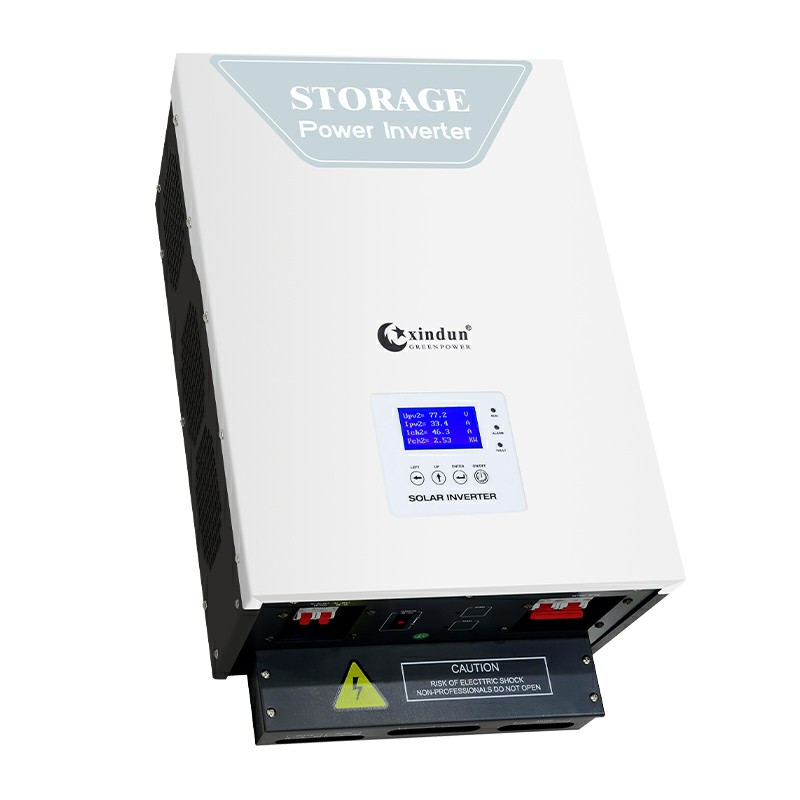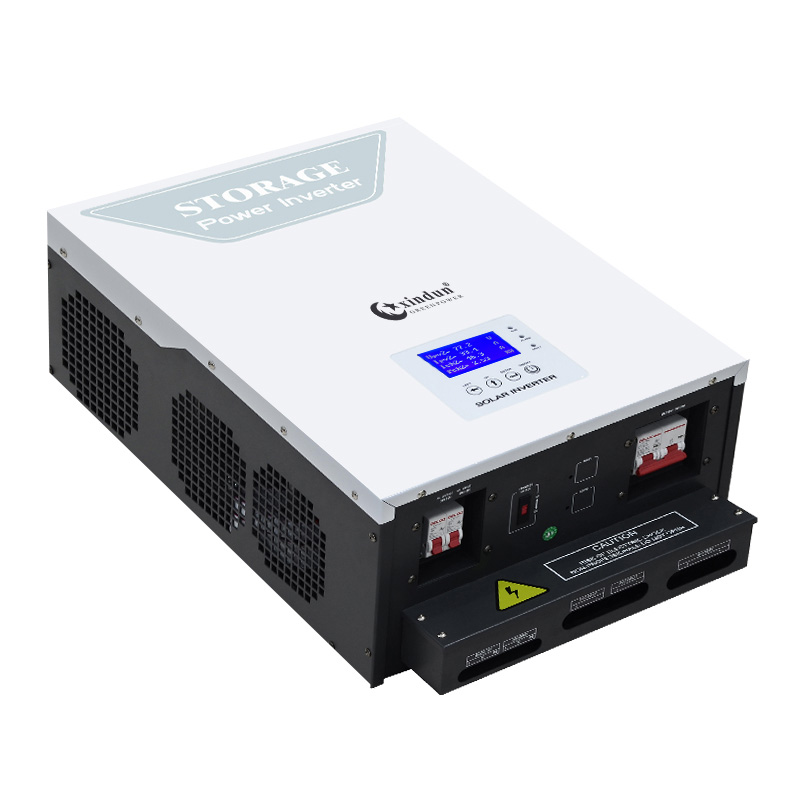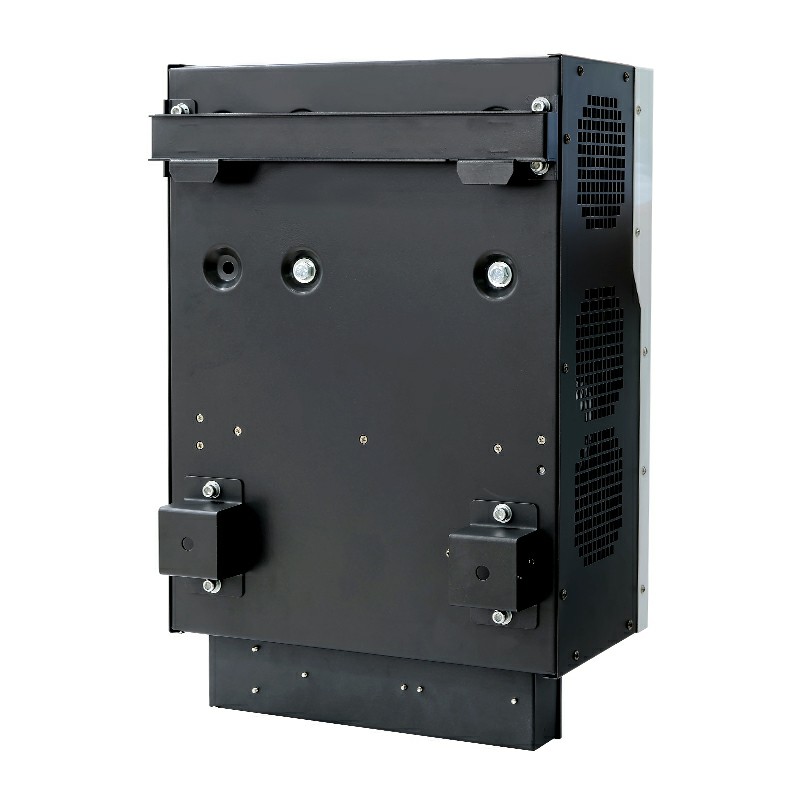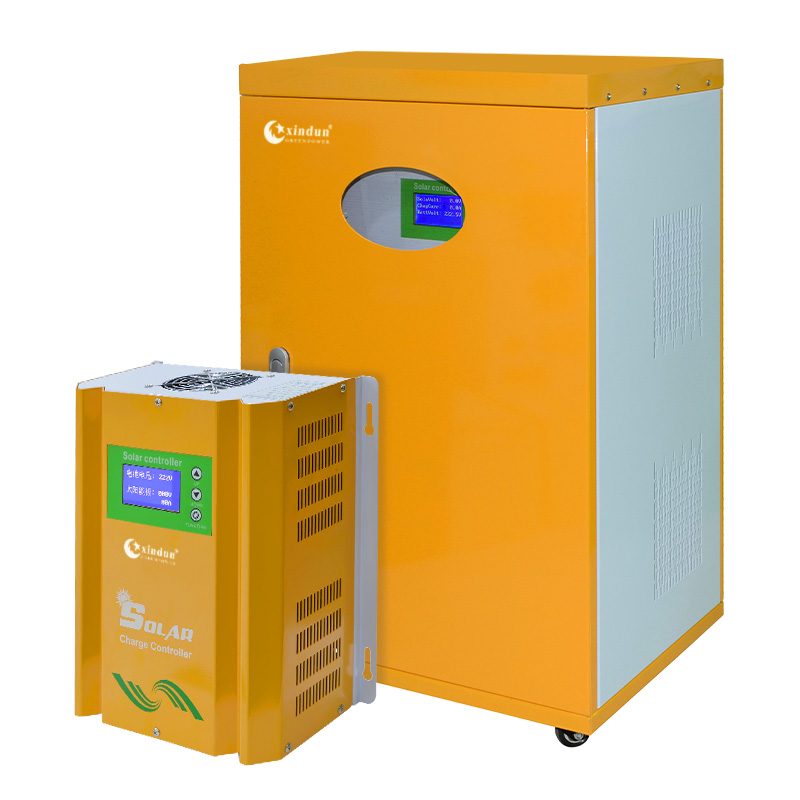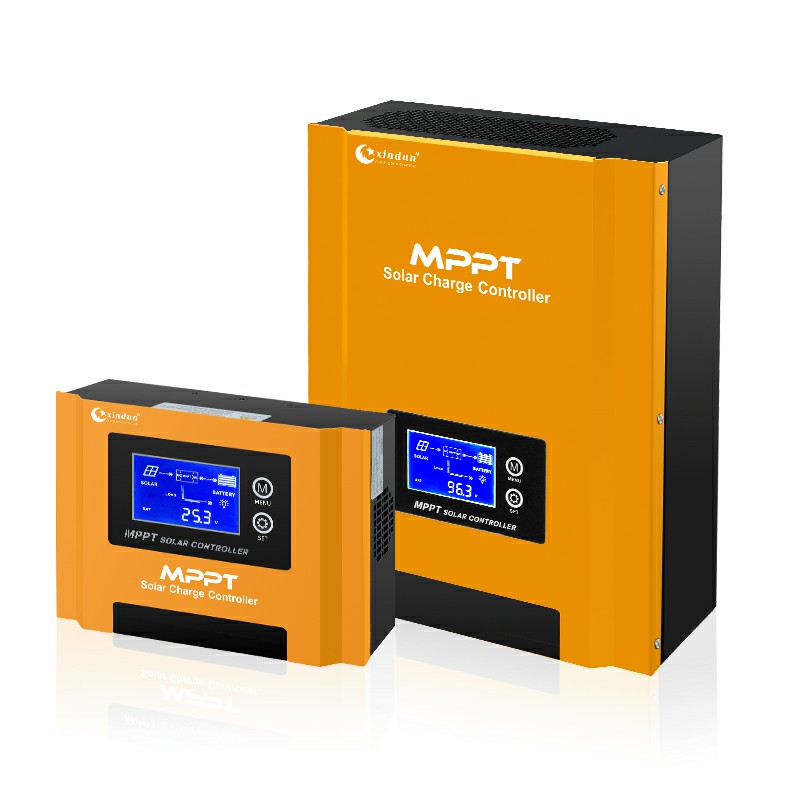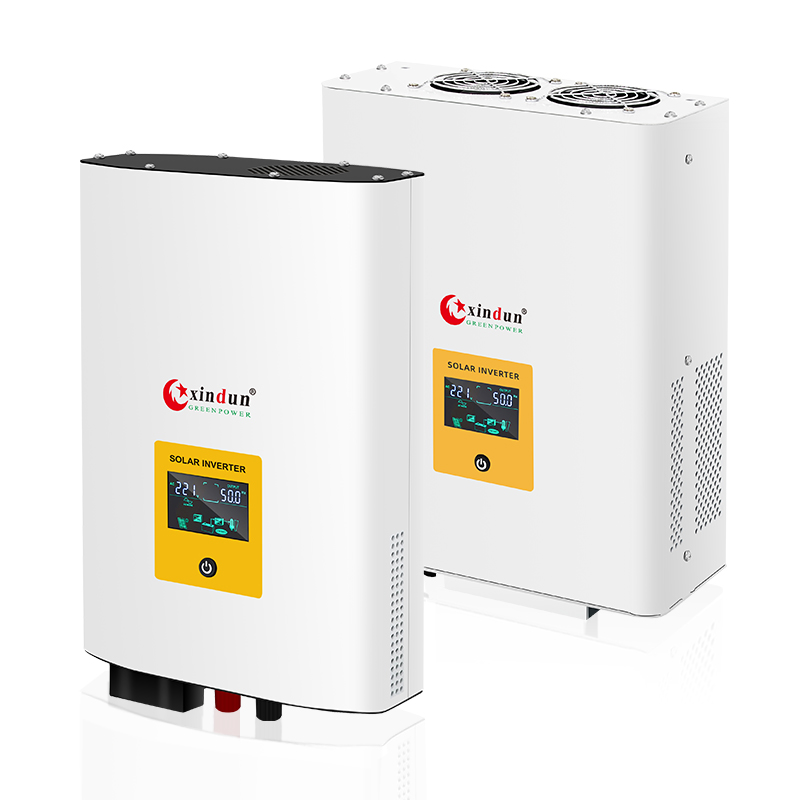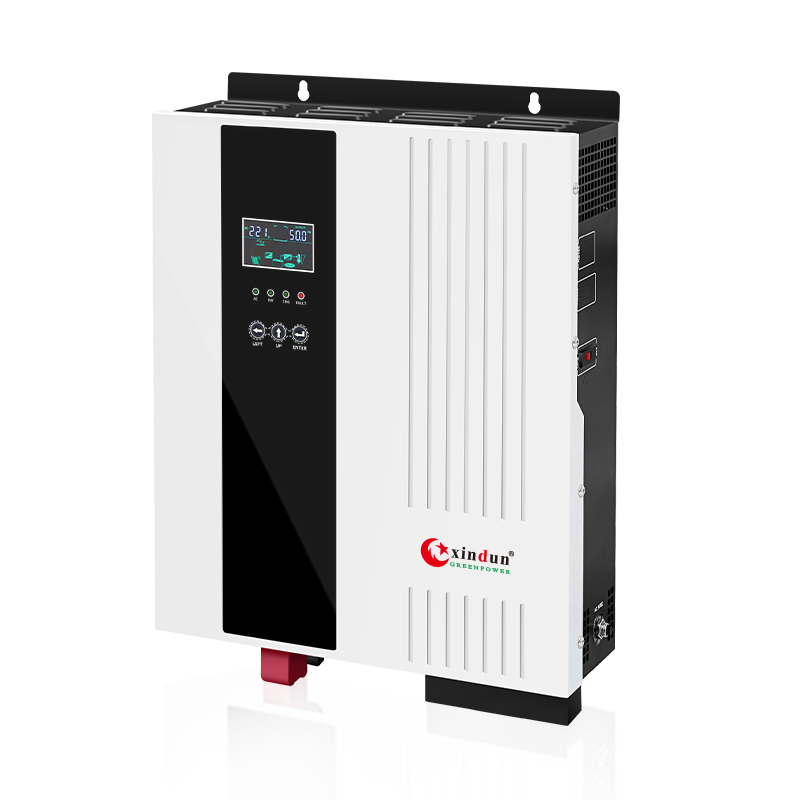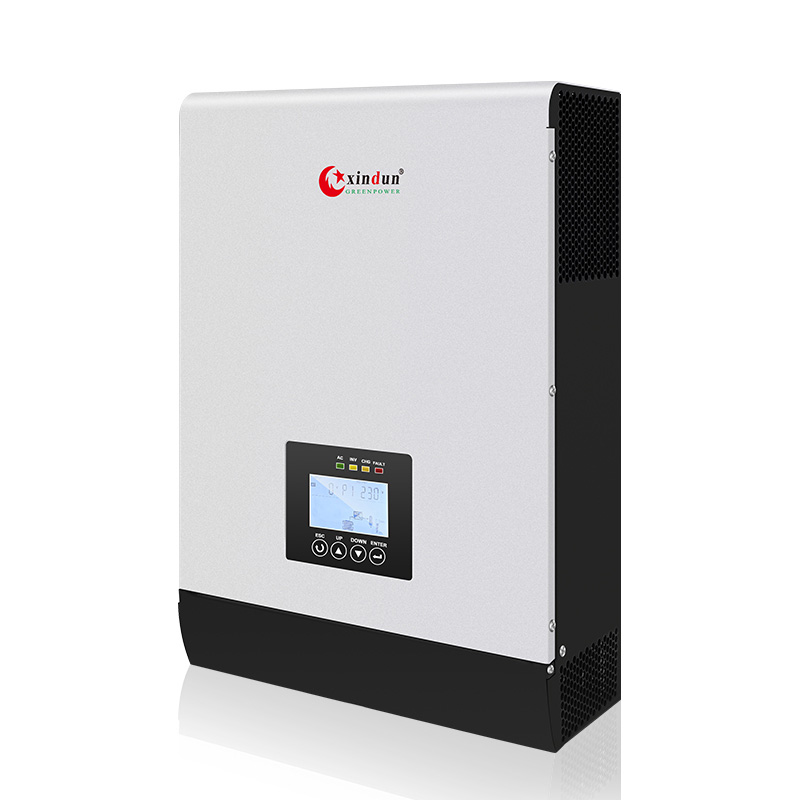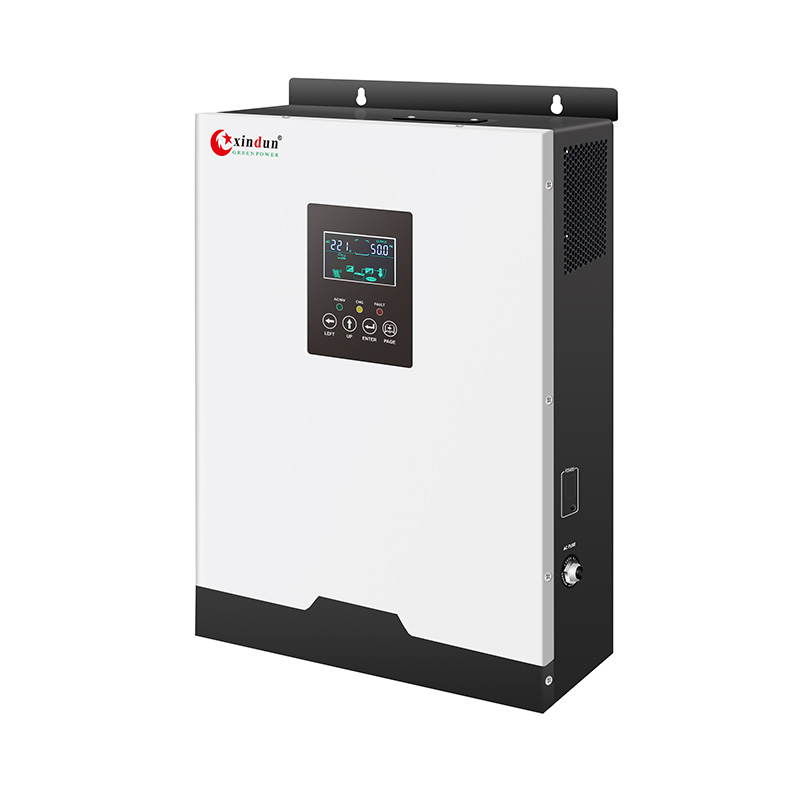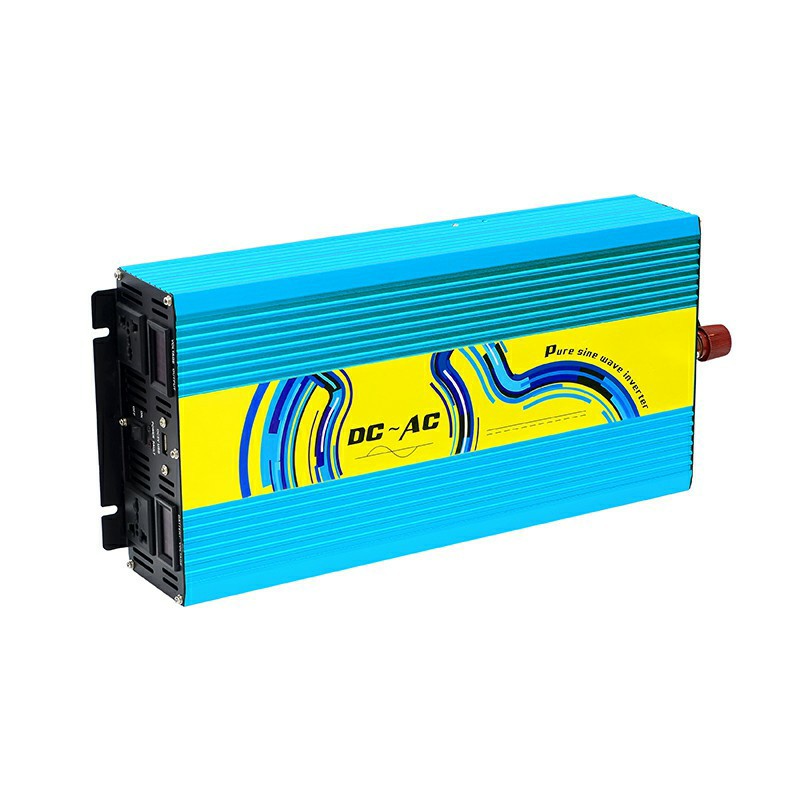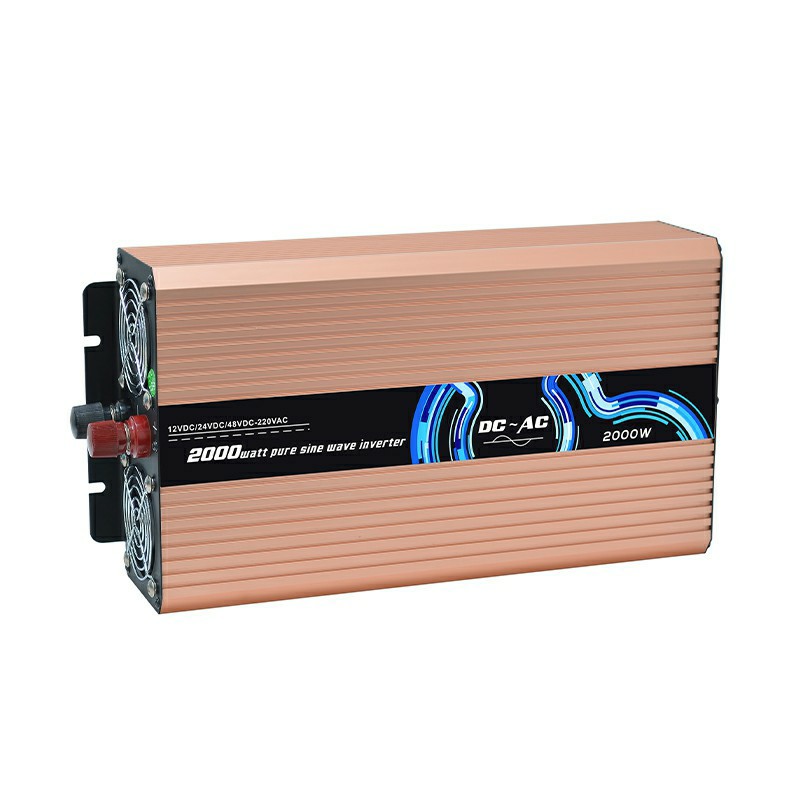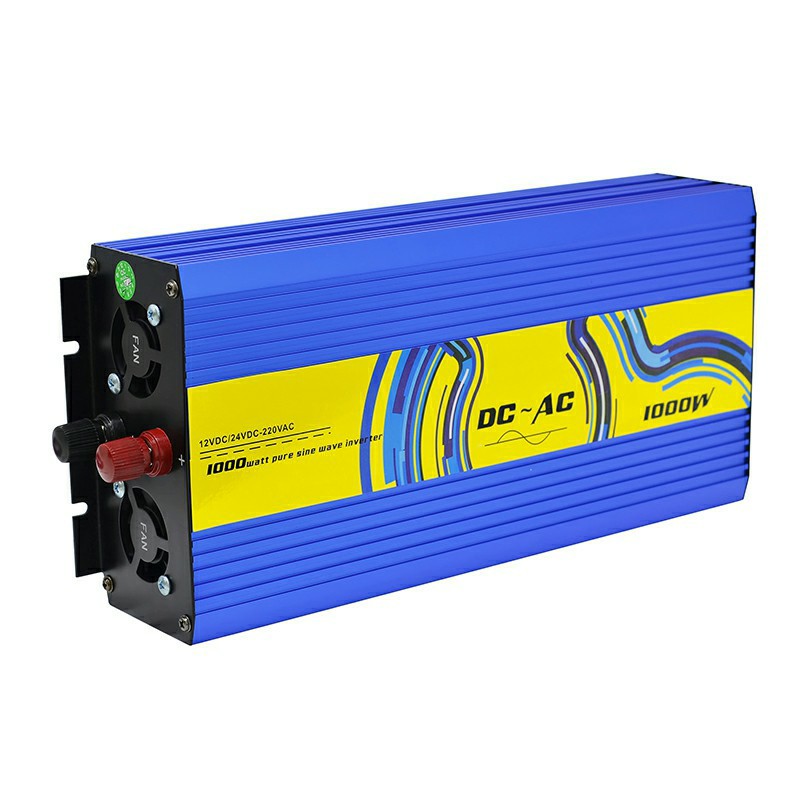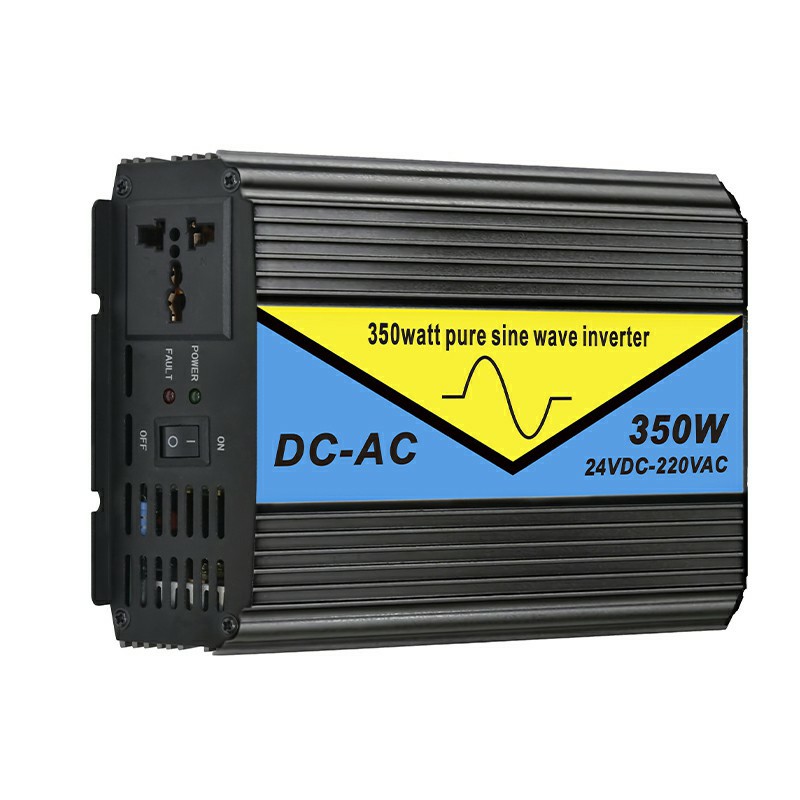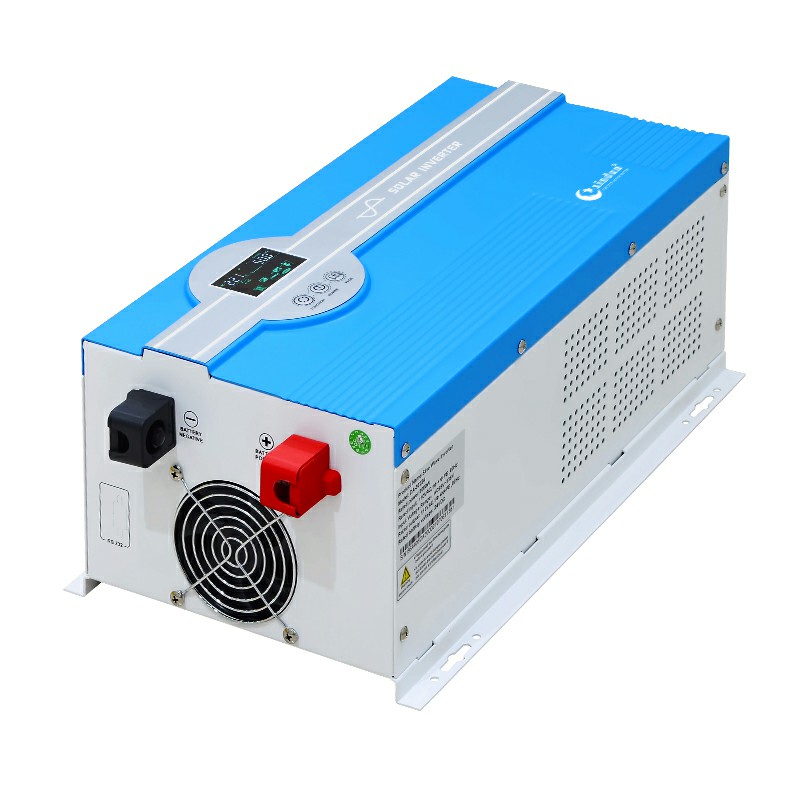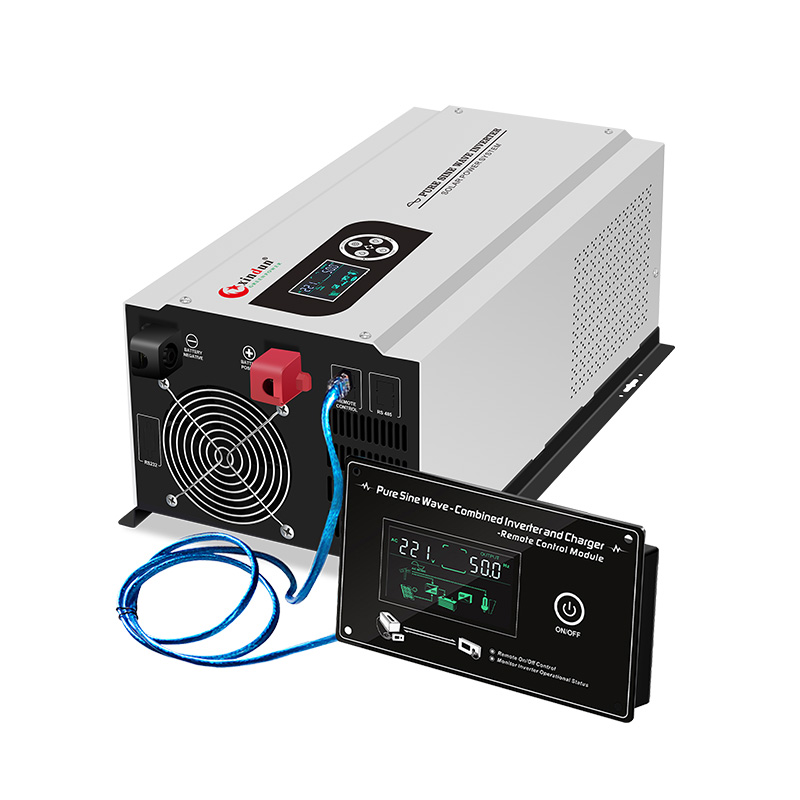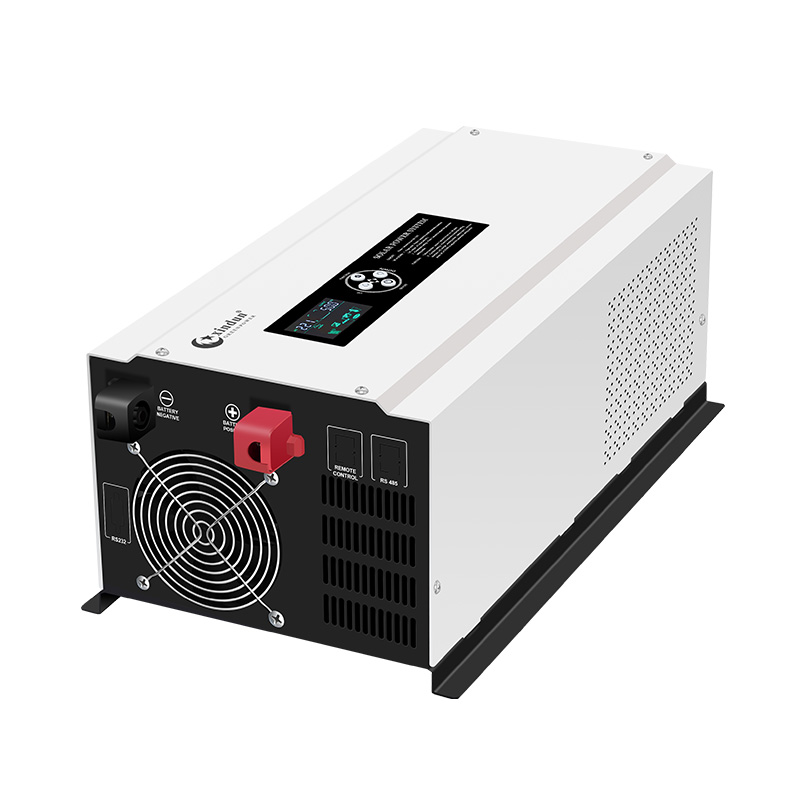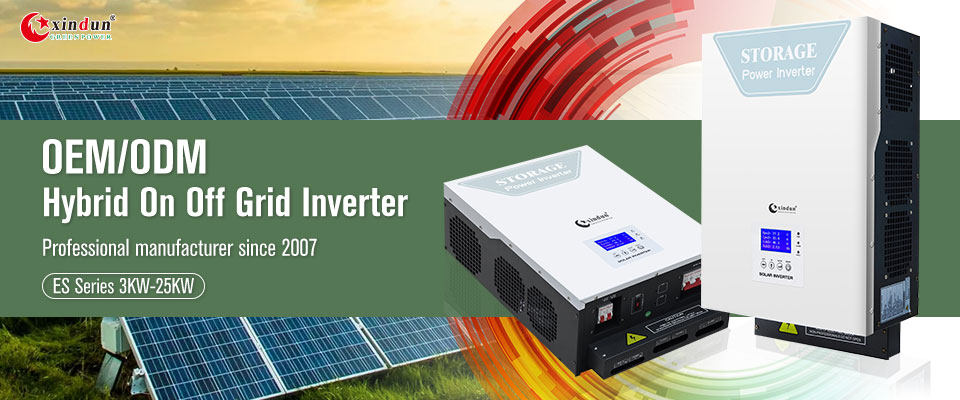
# Why Use Hybrid On Off Grid Inverter?
1) Off-grid power generation, which can be used as a backup power supply in the event of a power outage
When the grid fails, the on off grid solar inverter grid-connected mode stops working and automatically switches to the off-grid mode, the solar energy continues to generate electricity to provide uninterrupted power for the load, and the remaining photovoltaic energy is stored in the battery.
2) Cut peaks and fill valleys to help you generate income
During trough periods (when electricity prices are low), the grid charges the battery through the on off grid solar inverter. During peak electricity consumption periods (when electricity prices are high), the on off grid solar inverter feeds full power into the grid. In the case of meeting the load demand, the battery power is also fed into the grid to achieve the purpose of selling electricity to the grid. By using on off grid solar inverters, not only can electricity consumption be reduced, but also the economic benefits of peak-to-valley electricity bills can be obtained.
Peak and trough time periods can be set by the user.
3) Photovoltaic energy is fully utilized
The system prioritizes photovoltaic energy in any operating mode. When the photovoltaic energy is insufficient, it can be supplemented by the grid or battery. When there is excess photovoltaic power, the battery is stored or sent to the power grid for self-use purposes, and the excess power is sent to the power grid to achieve full utilization of photovoltaic power generation.
4) Both PV/AC can charge the battery
This on off grid hybrid inverter is compatible with lead-acid batteries, lithium-ion and other battery types. Both PV/AC can use 3-cell/2-cell charging mode to charge the battery, which can prolong the battery life.
# Benefits Of Hybrid On Off Grid Inverter
◆ Integrated intelligent energy management system, a variety of modes can be set;
◆ On off grid inverter can cut peaks and fill valleys to reduce grid pressure and maximize profits;
◆ Dual MPPT input, precise algorithm, efficient use of PV energy;
◆ On off grid hybrid inverter supports multiple parallel operations for user expansion;
◆ 3-stage/2-stage charging technology to protect battery life;
◆ Two-way energy storage design, PV, mains can charge the battery;
◆ Support multiple remote monitoring of communication software. (RS485/APP(WIFI monitoring or GPRS monitoring)
# On Off Grid Hybrid Inverter Details

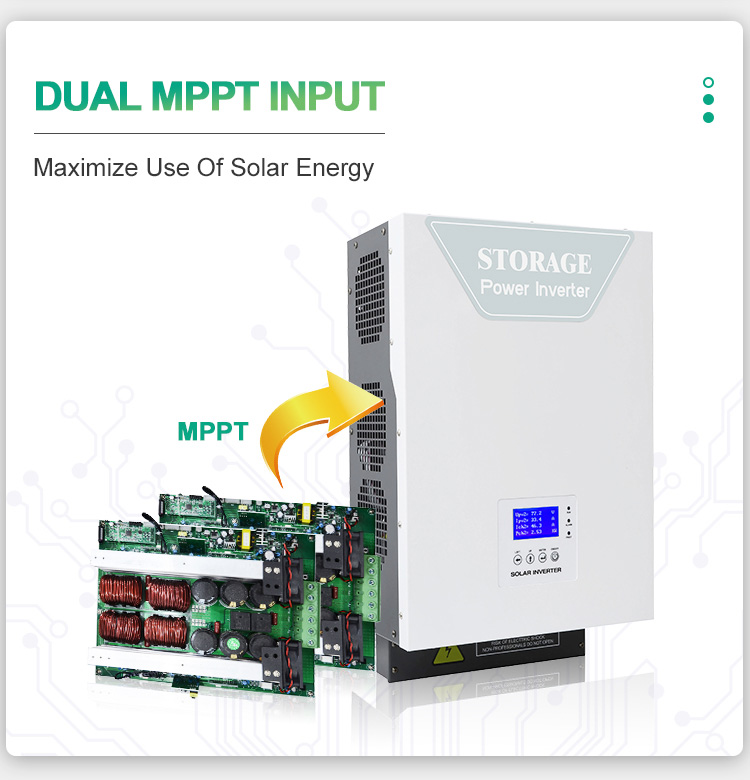




# Hybrid On Off Grid Inverter Wiring Diagram
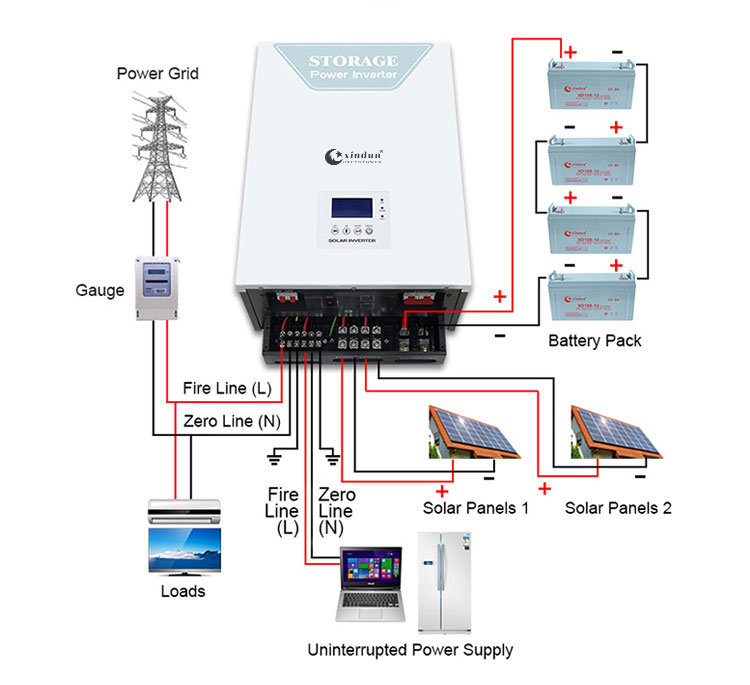
The electricity generated by solar energy can be stored in batteries and can be used day and night. Excess electricity can be sold to the power grid.
# Hybrid On Off Grid Inverter Specification
| Parameters |
| Model: ES | 30248 | 50248 | 80296 | 10396 | 153192 | 203192 | 253240 |
| PV Input | Max input voltage(Voc) (At the lowest temperature) | 150V | 300V | 450V | 500V |
| MPPT tracking range | 60V~120V | 120V-240V | 240V-360V | 300V-400V |
| Recommended operating voltage range | 60V~80V | 120V-160V | 240V-320V | 300V-380V |
| MPPT route number | 2
|
| Max input power | 1960W/1960W | 3360W/3360W | 5000W/5000W | 6150W/6150W | 8.8KW/8.8KW | 11.2KW/11.2KW | 14KW/14KW |
| Battery | Type of battery | Lead-acid battery / Lithium-ion battery |
| Rated voltage | 48V | 96V | 192V | 192V | 240V |
Max charging current
(Can be set,Recommended 0.1C) | 70A(PV)/ 35A(Mains) | 120A(PV)/ 60A(Mains) | 100A(PV)/ 40A(Mains) | 110A(PV)/ 60A(Mains) | 80A(PV)/ 40A(Mains) | 110A(PV)/ 60A(Mains) | 110A(PV)/ 60A(Mains) |
| Float voltage(Can be set) | 55.2V | 110.4V | 220.8V | 276V |
| Charge voltage(Can be set) | 56.8V | 113.6V | 227.2V | 284V |
| Charging method | 3-stage/2-stage |
| AC Input | Rated voltage | 220V/230V |
| Input voltage range | 187V~264V |
| Rated input frequency | 45Hz~55Hz(50Hz) / 55Hz~65Hz(60Hz) |
| Islanding Protection | ≤2S |
| Reconnection time | 30S
|
AC output (off grid mode) | Rated output power | 3KW | 5KW | 8KW | 10KW | 15KW | 20KW | 25KW |
| Rated output voltage | 220V/230V |
| Output voltage accuracy | ±2% |
| Rated output frequency | 50Hz/60Hz |
| Output frequency accuracy | ±1% |
AC output (on grid mode) | Rated output power | 3KW | 5KW | 8KW | 10KW | 15KW | 20KW | 25KW |
| Rated output current | 13.6A | 22.7A | 36.4A | 45.5A | 68.2A | 90.1A | 113.6A |
| Output voltage | 187V~264V |
| Output frequency | 47~52Hz/57~62Hz |
| Power Factor | >0.99(Rated power) |
| Protection | Output short circuit | Yes |
| Over load | Yes |
| Over-voltage/under-voltage | Yes |
| Over-frequency/under-frequency | Yes |
| Over temperature | Yes |
| Island protection | Yes |
| Regular Parameter | Topology | Transformer isolation |
| Display | LCD+LED |
| Communication(Optional) | RS485/APP(WIFI monitoring or GPRS monitoring) |
| Operating temperature | '-10℃~60℃(Derating above 45°C) |
| Storage temperature | '-20℃~60℃ |
| Noise | ≤60dB |
| Relative humidity | 0%~95%(No condensation) |
| Highest altitude | 2000m(More than derating) |
| Machine dimension(L*W*Hmm) | 592*380*265 | 550*380*675 | 620*380*825 |
| Package dimension(L*W*Hmm) | 650*435*290 | 610*440*800 | 680*440*950
|
| N.W(kg) | 36 | 45 | 70 | 75 | 128 | 134 | 140 |
| G.W(kg) | 40 | 49 | 80 | 85 | 140 | 146 | 152 |
| Installation Method | Wall-Mounted | Tower
|
| Note: All specifications are subject to charge without prior notice |
# The hybrid on off grid inverter has three working modes
According to different states and conditions, the main working modes are as follows. AC/DC switch key (the key is located on the back of the grid-connected inverter). If AC is selected,the priority mode is grid power; if DC is selected, the priority mode will be battery power.
1) AC Mode
1. When the grid is normal and the current solar power generation is greater than the load power, the solar energy will fully supply power to the load, and the remaining solar energy will supply power to the battery and transmit it to the grid.
2. When the power grid is normal and the solar power generation is less than the load power, the insufficient part will be supplemented by the power grid; the solar power and the power grid will supply power to the load together.
3. When the grid is abnormal, the hybrid on off grid inverter changes to independent inverter mode. When the solar power is greater than the load power, the solar power will fully power the load, and the remaining part will charge the battery. When the solar power is less than the load power, the insufficient part is supplemented by the battery; the battery and the solar power supply power to the load together.
4. When the solar energy is not generating electricity, the grid will charge and store energy to the battery through the hybrid on off grid inverter.
5. When the grid is abnormal and there is no solar energy, the battery will supply power to the load.
Advantages in AC Mode:
1. The on off grid hybrid solar energy system gives priority to using solar energy. When the solar energy is not enough to meet the local load, it will be supplemented by the grid, which can make full use of the solar energy.
2. The battery will only discharge when the solar energy is insufficient and the grid fails. Under normal circumstances, the battery is always in a fully charged state, which greatly extends the life of the battery.
2) Battery mode
1. When the grid is normal and the current solar power generation is greater than the load power, the solar energy will fully supply power to the load, and the remaining solar energy will supply power to the battery and transmit it to the grid.
2. When the solar power is less than the load power, the insufficient part is supplemented by the battery. The solar and battery will work together to power the load.
3. When the solar power is exhausted or the power is very low and the battery is placed below 48V, the discharge power of the battery will decrease linearly. The shortfall is supplemented by the grid. And when the battery low voltage protection is reached,the load will be completely powered by the grid.
4. When the grid is abnormal, the on off grid hybrid inverter works in independent inverter mode. Solar power will power the load. And if the solar energy is insufficient, it will be supplemented by the battery.
NOTE: In BATT mode, the grid will not charge the battery if there is no solar power.
Advantages in battery mode:
1. The on off grid hybrid solar energy system preferentially uses solar energy, and the grid is only used as the last supplementary power source when the solar energy and batteries are insufficient, which greatly reduces the electricity cost of users.
2. There is no frequent switching between the battery and the power grid, the battery is charged and discharged less frequently, and the service life is relatively long.
3. The solar energy/battery complements the power grid perfectly, and the load power supply is stable.
3) Peak shaving and valley filling in power mode (this mode needs to work in inverter battery priority mode)
This mode is suitable for areas with peak and valley electricity prices. According to the price of electricity in different time periods, you can set the corresponding time to charge and discharge from the grid.
1. When the electricity price is low, the grid charges the battery;
2 .When the electricity price is high, the battery supplies power to the load.
# Why Choose Us?
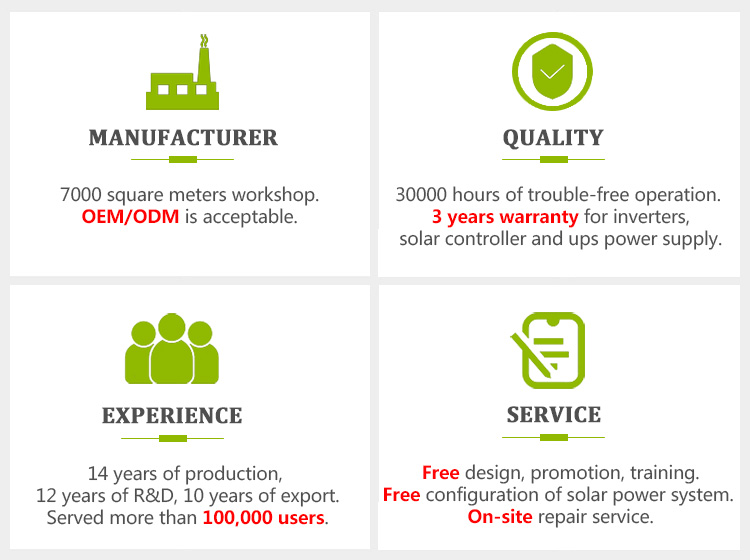
▷R&D Ability
Xindun have 20+ senior engineer and is at the top of the industry.ISO 9001:2015,ISO 14001:2015,10+ Software Copyright,20+ Patent Certificates, 50+ Honorary Certificates.
▷OEM/ODM
We can provide customized services: logo, machine appearance,special voltage and power, etc. The products you see on other website which is same with us, they are all from Xindun Power.
▷Warranty
The warranty of Xindun products is 2~3 years(Industry-wide warranty is 1 year).
▷After-Sales Service
Xindun's product failure rate is within 5%, which is far lower than the average in the industry. We promise to solve the after-sales problems within 48 hours.We have cooperated with many customers for more than 10 years,without perfect after-sales service, they cannot always choose xindun!
# About Xindun Power
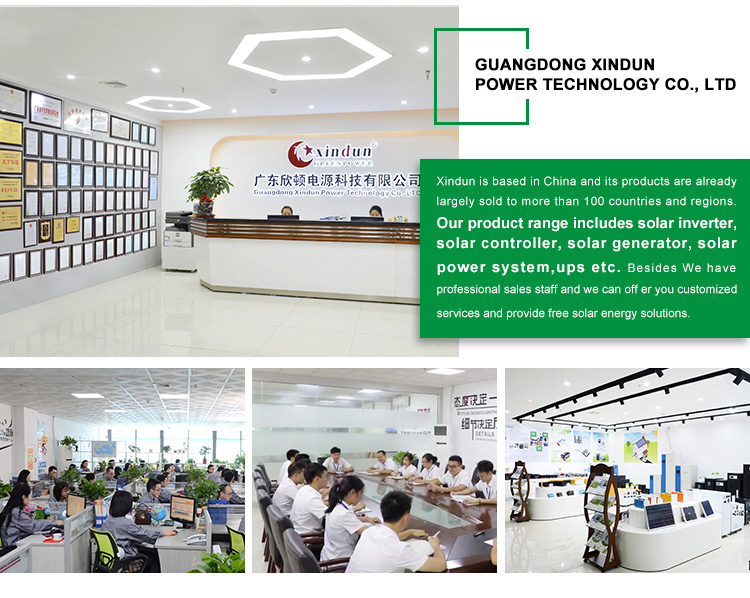
Guangdong Xindun Power Technology Co.,Ltd-Takes innovation as the core, grasps the leading photovoltaic power generation technology, and joins the advanced industrial Internet of things and big data technology to realize the successful application of cloud computing in the field of energy management. In the industry for more than 15 years of outstanding performance, let us become a strong influence in the field of companies.
★Factory Location-Foshan,Guangdong,China
★Main Market-Africa, Middle East, Asia & South America. (Ukraine, Russia, Vietnam, Pakistan, Nigeria, Kenya, South Afriac, Ghana, Thailand,Philippines, etc.)
★Factory-7000+Square Meters, 100+ workers
★Product Range-solar inverter,3 phase inverter,hybrid inverter,UPS,solar charge controller,solar power system,mini solar dc system
★Department-R&D, Production, Sales, Marketing, Purchasing, QA, After-sale service department
★Certificate-ISO 14001:2015, CE, IEC, TUV etc.
★Patent-Software Paten, Design Patent, Project Pantent
# Qualifications and Certificates
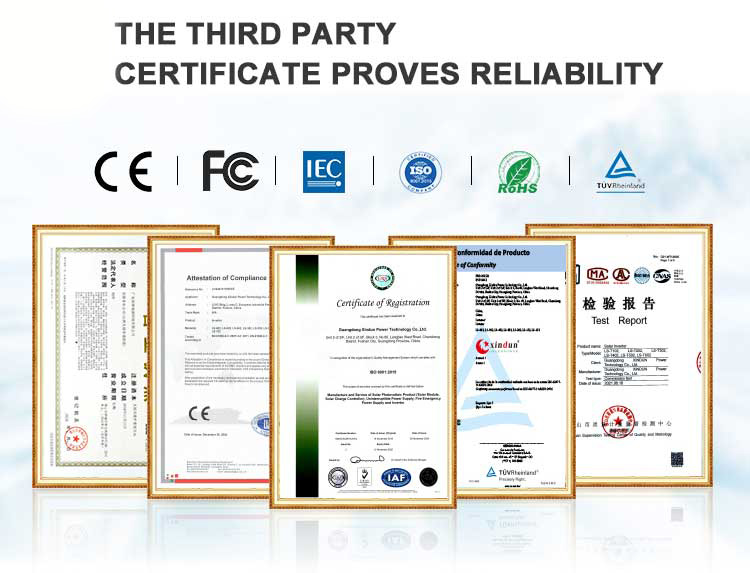
# Factory Workshop
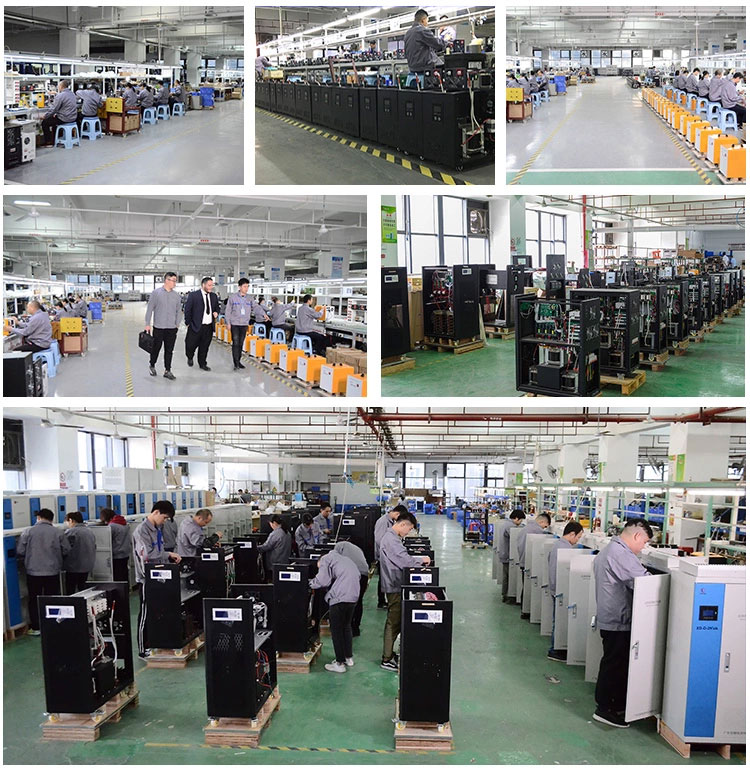
We have nearly 8,000 square meters of standard solar inverter production factory, advanced R&D testing capabilities and hybrid on off grid inverter production equipment.Strict quality inspection and manufacturing process control.

# On Off Grid Solar Inverter Production Process
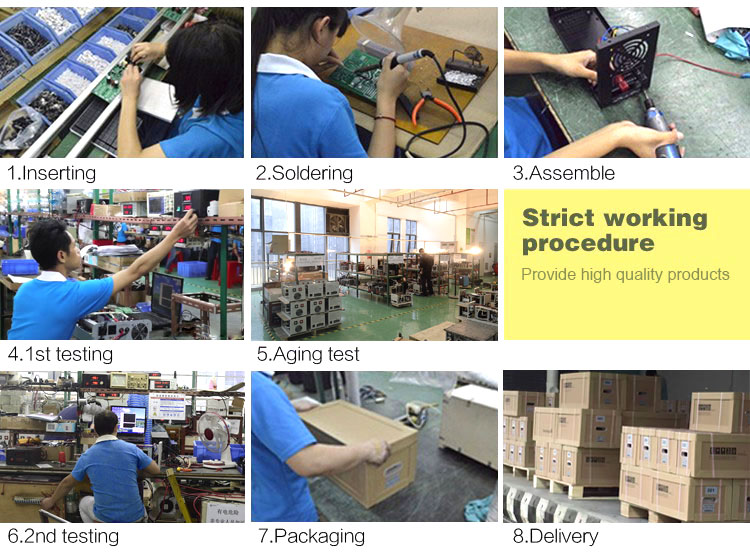
# Our Respected Global Customers

# Frequently Asked Questions
Q1:What is on off grid inverter?
A1:The on off grid hybrid inverter can meet the functions of both the grid-connected inverter and the off grid inverter. On the one hand, the on off grid hybrid inverter does not need to store any batteries. It is converted into alternating current by solar inverter and sent to the public power grid. On the other hand, the on off grid hybrid inverter can also be separated from the public grid system, and the direct current generated by the solar panel is first stored in the battery, and then sent to the off grid inverter to converted to AC power, which can be directly used by the load or returned to the battery for storage power.
Q2:Can I use a grid-connected inverter off-grid?
A2:The grid-connected can be used directly off-grid, because the grid-connected inverter can be used directly as an off-grid inverter.
Q3:What is the difference between on grid and off grid inverter?
A3:The grid-connected inverter can directly transmit energy to the grid, so it is necessary to track the frequency and phase of the grid, which is equivalent to a current source. The off grid inverter is equivalent to establishing an independent power grid. The main function is to control its own voltage, which is itself a voltage source. Grid-connected inverters do not require energy storage,however, the energy cannot be adjusted, and the off grid inverter needs energy storage, but does not transmit energy to the grid.
Q4:Which is better on-grid or off-grid solar?
A4:Being grid-tied is beneficial because you don't have to buy an expensive battery back-up system to store any excess energy. Being off-grid means you are not connected in any way to your grid's power system or utility company. This is appealing because you are 100% self-sustaining your energy use.
Q5:Can we use battery in on-grid solar system?
A5:These systems do not require batteries and are connected to the public grid through the use of solar inverters or microinverters.
Model Number:ES on off grid hybrid inverter
Rated output power: 3KW-25KW
Battery Voltage: DC48V-240V
Output: 220VAC,230VAC /50Hz/60Hz
Output waveform:Pure Sine Wave hybrid on off grid inverter
Certificate:CE RoHS ISO,etc
OEM/ODM:Accepted,factory wholesales at low price

# Why Use Hybrid On Off Grid Inverter?
1) Off-grid power generation, which can be used as a backup power supply in the event of a power outage
When the grid fails, the on off grid solar inverter grid-connected mode stops working and automatically switches to the off-grid mode, the solar energy continues to generate electricity to provide uninterrupted power for the load, and the remaining photovoltaic energy is stored in the battery.
2) Cut peaks and fill valleys to help you generate income
During trough periods (when electricity prices are low), the grid charges the battery through the on off grid solar inverter. During peak electricity consumption periods (when electricity prices are high), the on off grid solar inverter feeds full power into the grid. In the case of meeting the load demand, the battery power is also fed into the grid to achieve the purpose of selling electricity to the grid. By using on off grid solar inverters, not only can electricity consumption be reduced, but also the economic benefits of peak-to-valley electricity bills can be obtained.
Peak and trough time periods can be set by the user.
3) Photovoltaic energy is fully utilized
The system prioritizes photovoltaic energy in any operating mode. When the photovoltaic energy is insufficient, it can be supplemented by the grid or battery. When there is excess photovoltaic power, the battery is stored or sent to the power grid for self-use purposes, and the excess power is sent to the power grid to achieve full utilization of photovoltaic power generation.
4) Both PV/AC can charge the battery
This on off grid hybrid inverter is compatible with lead-acid batteries, lithium-ion and other battery types. Both PV/AC can use 3-cell/2-cell charging mode to charge the battery, which can prolong the battery life.
# Benefits Of Hybrid On Off Grid Inverter
◆ Integrated intelligent energy management system, a variety of modes can be set;
◆ On off grid inverter can cut peaks and fill valleys to reduce grid pressure and maximize profits;
◆ Dual MPPT input, precise algorithm, efficient use of PV energy;
◆ On off grid hybrid inverter supports multiple parallel operations for user expansion;
◆ 3-stage/2-stage charging technology to protect battery life;
◆ Two-way energy storage design, PV, mains can charge the battery;
◆ Support multiple remote monitoring of communication software. (RS485/APP(WIFI monitoring or GPRS monitoring)
# On Off Grid Hybrid Inverter Details






# Hybrid On Off Grid Inverter Wiring Diagram

The electricity generated by solar energy can be stored in batteries and can be used day and night. Excess electricity can be sold to the power grid.
# Hybrid On Off Grid Inverter Specification

# The hybrid on off grid inverter has three working modes
According to different states and conditions, the main working modes are as follows. AC/DC switch key (the key is located on the back of the grid-connected inverter). If AC is selected,the priority mode is grid power; if DC is selected, the priority mode will be battery power.
1) AC Mode
1. When the grid is normal and the current solar power generation is greater than the load power, the solar energy will fully supply power to the load, and the remaining solar energy will supply power to the battery and transmit it to the grid.
2. When the power grid is normal and the solar power generation is less than the load power, the insufficient part will be supplemented by the power grid; the solar power and the power grid will supply power to the load together.
3. When the grid is abnormal, the hybrid on off grid inverter changes to independent inverter mode. When the solar power is greater than the load power, the solar power will fully power the load, and the remaining part will charge the battery. When the solar power is less than the load power, the insufficient part is supplemented by the battery; the battery and the solar power supply power to the load together.
4. When the solar energy is not generating electricity, the grid will charge and store energy to the battery through the hybrid on off grid inverter.
5. When the grid is abnormal and there is no solar energy, the battery will supply power to the load.
Advantages in AC Mode:
1. The on off grid hybrid solar energy system gives priority to using solar energy. When the solar energy is not enough to meet the local load, it will be supplemented by the grid, which can make full use of the solar energy.
2. The battery will only discharge when the solar energy is insufficient and the grid fails. Under normal circumstances, the battery is always in a fully charged state, which greatly extends the life of the battery.
2) Battery mode
1. When the grid is normal and the current solar power generation is greater than the load power, the solar energy will fully supply power to the load, and the remaining solar energy will supply power to the battery and transmit it to the grid.
2. When the solar power is less than the load power, the insufficient part is supplemented by the battery. The solar and battery will work together to power the load.
3. When the solar power is exhausted or the power is very low and the battery is placed below 48V, the discharge power of the battery will decrease linearly. The shortfall is supplemented by the grid. And when the battery low voltage protection is reached,the load will be completely powered by the grid.
4. When the grid is abnormal, the on off grid hybrid inverter works in independent inverter mode. Solar power will power the load. And if the solar energy is insufficient, it will be supplemented by the battery.
NOTE: In BATT mode, the grid will not charge the battery if there is no solar power.
Advantages in battery mode:
1. The on off grid hybrid solar energy system preferentially uses solar energy, and the grid is only used as the last supplementary power source when the solar energy and batteries are insufficient, which greatly reduces the electricity cost of users.
2. There is no frequent switching between the battery and the power grid, the battery is charged and discharged less frequently, and the service life is relatively long.
3. The solar energy/battery complements the power grid perfectly, and the load power supply is stable.
3) Peak shaving and valley filling in power mode (this mode needs to work in inverter battery priority mode)
This mode is suitable for areas with peak and valley electricity prices. According to the price of electricity in different time periods, you can set the corresponding time to charge and discharge from the grid.
1. When the electricity price is low, the grid charges the battery;
2 .When the electricity price is high, the battery supplies power to the load.
# Why Choose Us?

▷R&D Ability
Xindun have 20+ senior engineer and is at the top of the industry.ISO 9001:2015,ISO 14001:2015,10+ Software Copyright,20+ Patent Certificates, 50+ Honorary Certificates.
▷OEM/ODM
We can provide customized services: logo, machine appearance,special voltage and power, etc. The products you see on other website which is same with us, they are all from Xindun Power.
▷Warranty
The warranty of Xindun products is 2~3 years(Industry-wide warranty is 1 year).
▷After-Sales Service
Xindun's product failure rate is within 5%, which is far lower than the average in the industry. We promise to solve the after-sales problems within 48 hours.We have cooperated with many customers for more than 10 years,without perfect after-sales service, they cannot always choose xindun!
# About Xindun Power

Guangdong Xindun Power Technology Co.,Ltd-Takes innovation as the core, grasps the leading photovoltaic power generation technology, and joins the advanced industrial Internet of things and big data technology to realize the successful application of cloud computing in the field of energy management. In the industry for more than 15 years of outstanding performance, let us become a strong influence in the field of companies.
★Factory Location-Foshan,Guangdong,China
★Main Market-Africa, Middle East, Asia & South America. (Ukraine, Russia, Vietnam, Pakistan, Nigeria, Kenya, South Afriac, Ghana, Thailand,Philippines, etc.)
★Factory-7000+Square Meters, 100+ workers
★Product Range-solar inverter,3 phase inverter,hybrid inverter,UPS,solar charge controller,solar power system,mini solar dc system
★Department-R&D, Production, Sales, Marketing, Purchasing, QA, After-sale service department
★Certificate-ISO 14001:2015, CE, IEC, TUV etc.
★Patent-Software Paten, Design Patent, Project Pantent
# Qualifications and Certificates

# Factory Workshop

We have nearly 8,000 square meters of standard solar inverter production factory, advanced R&D testing capabilities and hybrid on off grid inverter production equipment.Strict quality inspection and manufacturing process control.

# On Off Grid Solar Inverter Production Process

# Our Respected Global Customers

# Frequently Asked Questions
Q1:What is on off grid inverter?
A1:The on off grid hybrid inverter can meet the functions of both the grid-connected inverter and the off grid inverter. On the one hand, the on off grid hybrid inverter does not need to store any batteries. It is converted into alternating current by solar inverter and sent to the public power grid. On the other hand, the on off grid hybrid inverter can also be separated from the public grid system, and the direct current generated by the solar panel is first stored in the battery, and then sent to the off grid inverter to converted to AC power, which can be directly used by the load or returned to the battery for storage power.
Q2:Can I use a grid-connected inverter off-grid?
A2:The grid-connected can be used directly off-grid, because the grid-connected inverter can be used directly as an off-grid inverter.
Q3:What is the difference between on grid and off grid inverter?
A3:The grid-connected inverter can directly transmit energy to the grid, so it is necessary to track the frequency and phase of the grid, which is equivalent to a current source. The off grid inverter is equivalent to establishing an independent power grid. The main function is to control its own voltage, which is itself a voltage source. Grid-connected inverters do not require energy storage,however, the energy cannot be adjusted, and the off grid inverter needs energy storage, but does not transmit energy to the grid.
Q4:Which is better on-grid or off-grid solar?
A4:Being grid-tied is beneficial because you don't have to buy an expensive battery back-up system to store any excess energy. Being off-grid means you are not connected in any way to your grid's power system or utility company. This is appealing because you are 100% self-sustaining your energy use.
Q5:Can we use battery in on-grid solar system?
A5:These systems do not require batteries and are connected to the public grid through the use of solar inverters or microinverters.





